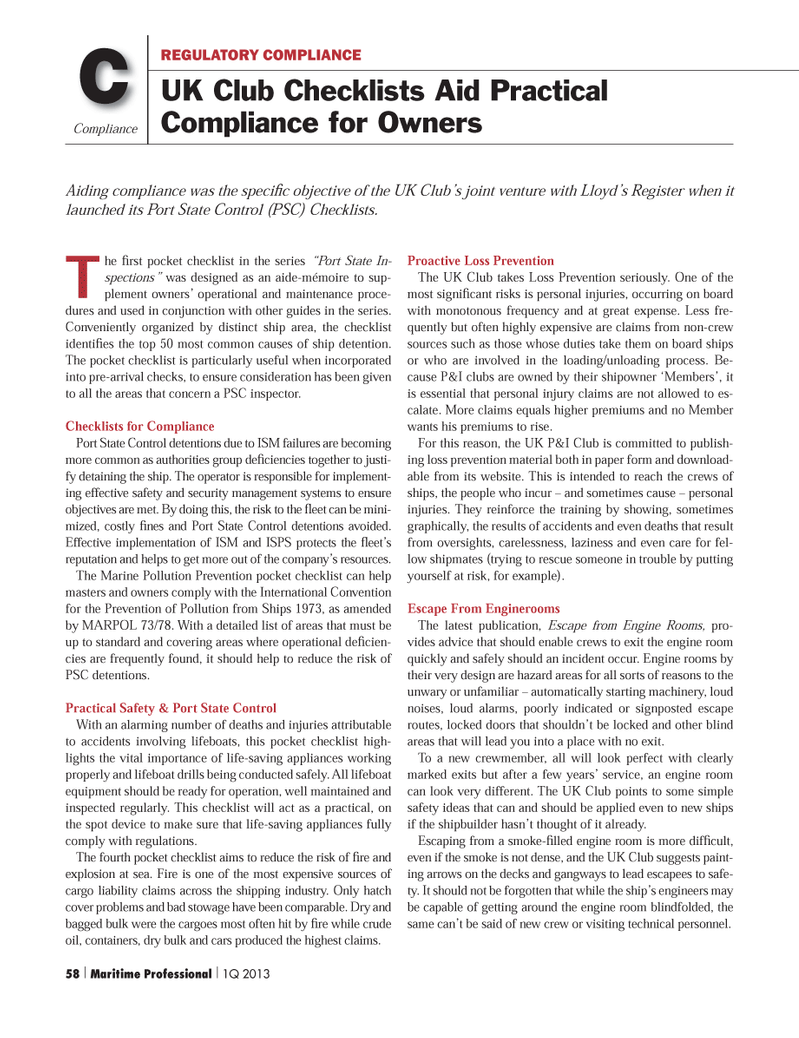
Page 58: of Maritime Logistics Professional Magazine (Q1 2013)
Maritime Risk
Read this page in Pdf, Flash or Html5 edition of Q1 2013 Maritime Logistics Professional Magazine
The Þ rst pocket checklist in the series ?Port State In- spections? was designed as an aide-m?moire to sup- plement ownersÕ operational and maintenance proce- dures and used in conjunction with other guides in the series. Conveniently organized by distinct ship area, the checklist identiÞ es the top 50 most common causes of ship detention. The pocket checklist is particularly useful when incorporated into pre-arrival checks, to ensure consideration has been given to all the areas that concern a PSC inspector. Checklists for Compliance Port State Control detentions due to ISM failures are becoming more common as authorities group deÞ ciencies together to justi-fy detaining the ship. The operator is responsible for implement- ing effective safety and security management systems to ensure objectives are met. By doing this, the risk to the ß eet can be mini- mized, costly Þ nes and Port State Control detentions avoided. Effective implementation of ISM and ISPS protects the ß eetÕs reputation and helps to get more out of the companyÕs resources. The Marine Pollution Prevention pocket checklist can help masters and owners comply with the International Convention for the Prevention of Pollution from Ships 1973, as amended by MARPOL 73/78. With a detailed list of areas that must be up to standard and covering areas where operational deÞ cien-cies are frequently found, it should help to reduce the risk of PSC detentions.Practical Safety & Port State Control With an alarming number of deaths and injuries attributable to accidents involving lifeboats, this pocket checklist high- lights the vital importance of life-saving appliances working properly and lifeboat drills being conducted safely. All lifeboat equipment should be ready for operation, well maintained and inspected regularly. This checklist will act as a practical, on the spot device to make sure that life-saving appliances fully comply with regulations. The fourth pocket checklist aims to reduce the risk of Þ re and explosion at sea. Fire is one of the most expensive sources of cargo liability claims across the shipping industry. Only hatch cover problems and bad stowage have been comparable. Dry and bagged bulk were the cargoes most often hit by Þ re while crude oil, containers, dry bulk and cars produced the highest claims. Proactive Loss Prevention The UK Club takes Loss Prevention seriously. One of the most signiÞ cant risks is personal injuries, occurring on board with monotonous frequency and at great expense. Less fre- quently but often highly expensive are claims from non-crew sources such as those whose duties take them on board ships or who are involved in the loading/unloading process. Be- cause P&I clubs are owned by their shipowner ÔMembersÕ, it is essential that personal injury claims are not allowed to es- calate. More claims equals higher premiums and no Member wants his premiums to rise. For this reason, the UK P&I Club is committed to publish- ing loss prevention material both in paper form and download- able from its website. This is intended to reach the crews of ships, the people who incur Ð and sometimes cause Ð personal injuries. They reinforce the training by showing, sometimes graphically, the results of accidents and even deaths that result from oversights, carelessness, laziness and even care for fel- low shipmates (trying to rescue someone in trouble by putting yourself at risk, for example). Escape From Enginerooms The latest publication, Escape from Engine Rooms, pro-vides advice that should enable crews to exit the engine room quickly and safely should an incident occur. Engine rooms by their very design are hazard areas for all sorts of reasons to the unwary or unfamiliar Ð automatically starting machinery, loud noises, loud alarms, poorly indicated or signposted escape routes, locked doors that shouldnÕt be locked and other blind areas that will lead you into a place with no exit. To a new crewmember, all will look perfect with clearly marked exits but after a few yearsÕ service, an engine room can look very different. The UK Club points to some simple safety ideas that can and should be applied even to new ships if the shipbuilder hasnÕt thought of it already. Escaping from a smoke-Þ lled engine room is more difÞ cult, even if the smoke is not dense, and the UK Club suggests paint- ing arrows on the decks and gangways to lead escapees to safe- ty. It should not be forgotten that while the shipÕs engineers may be capable of getting around the engine room blindfolded, the same canÕt be said of new crew or visiting technical personnel. ComplianceREGULATORY COMPLIANCE UK Club Checklists Aid Practical Compliance for OwnersCAiding compliance was the speci c objective of the UK Club?s joint venture with Lloyd?s Register when it launched its Port State Control (PSC) Checklists. 58 | Maritime Professional | 1Q 2013MP #4 50-63.indd 58MP #4 50-63.indd 582/25/2013 10:32:48 AM2/25/2013 10:32:48 AM

 57
57

 59
59
